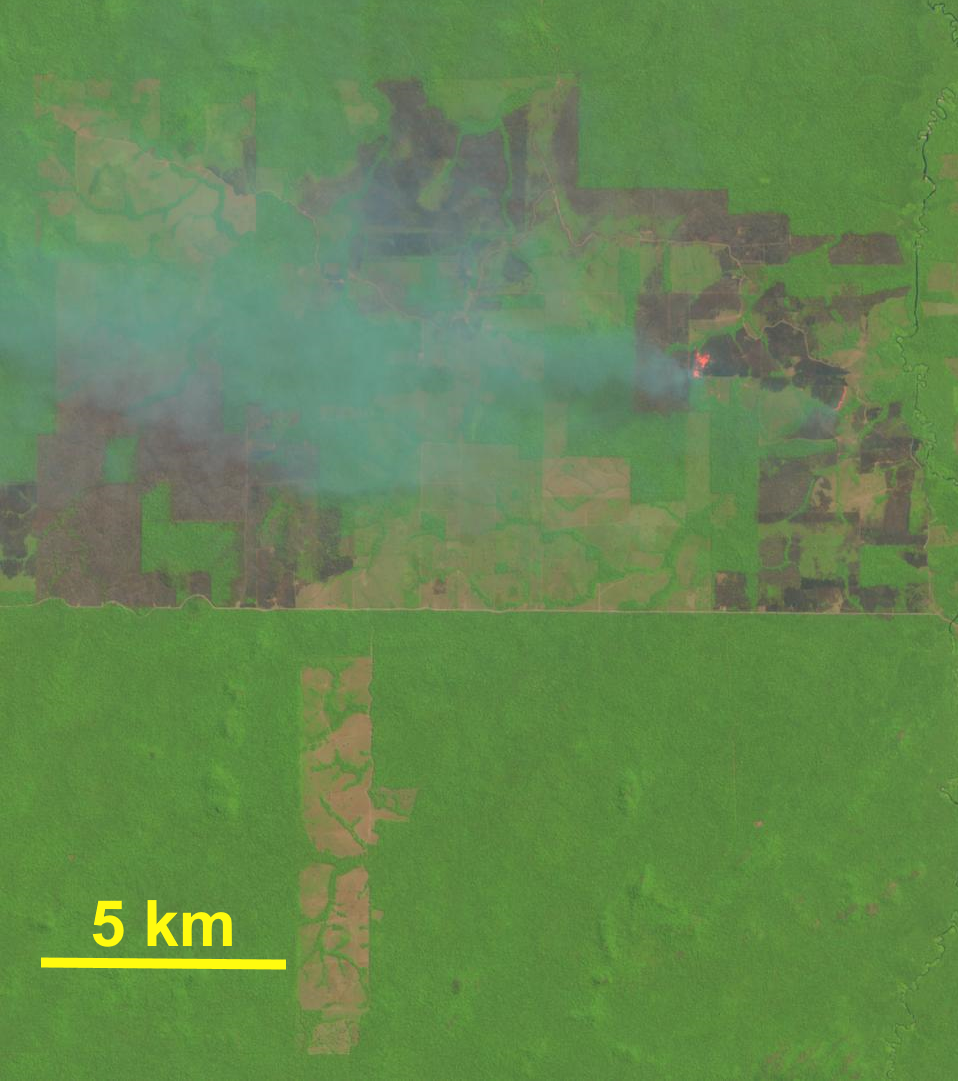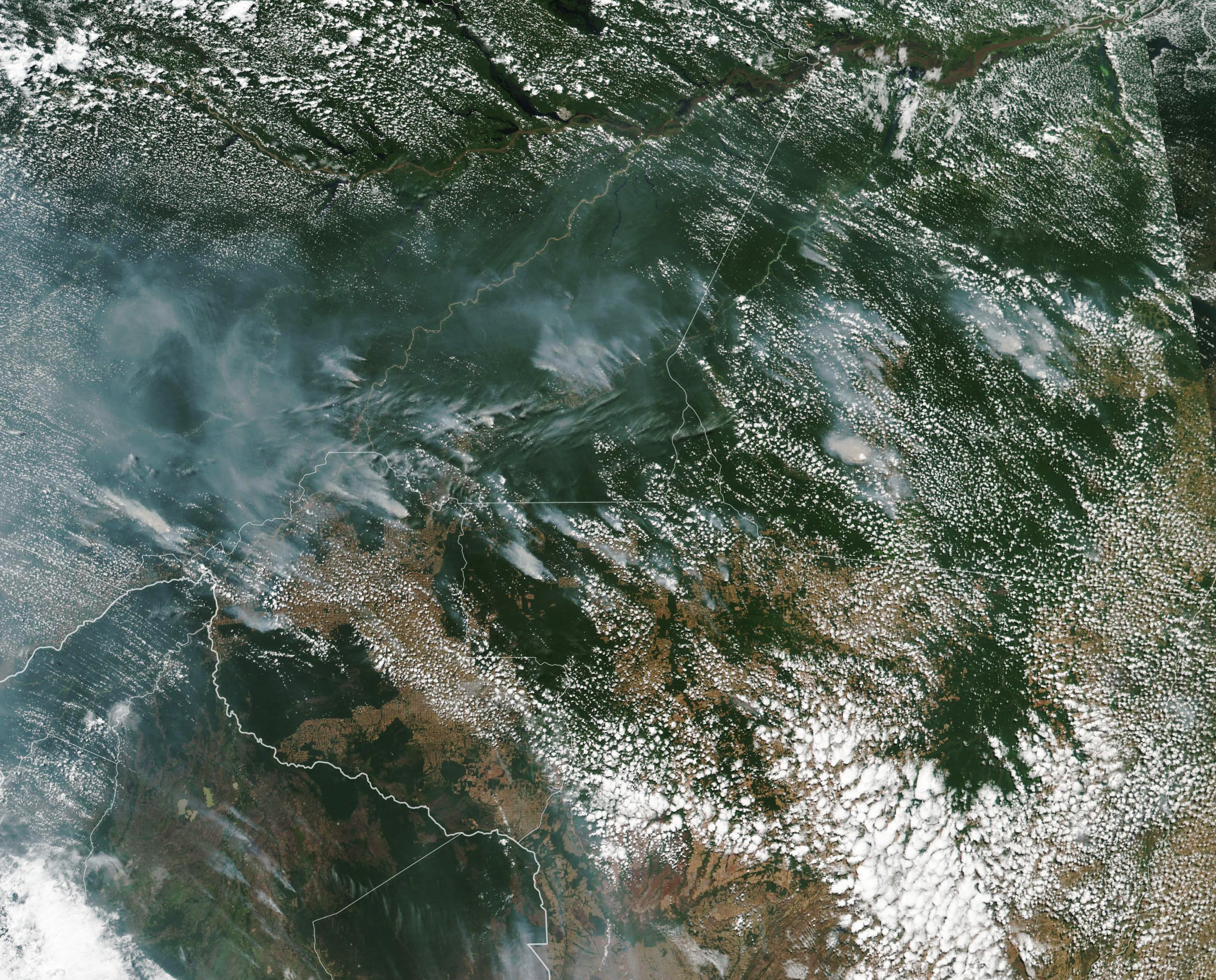Huge swathes of the Amazon rainforest are on fire with smoke from the fires clearly visible from space.
There have been over 74,000 fires in the Amazon so far this year – 85 per cent more than last year. As the Amazon provides the world with a large amount of its breathable oxygen, it has been stated that the fires could have a significant impact on climate change.
The SMC gathered expert comments on the fires, feel free to use these comments in your reporting.
Dr Duncan Steel, Xerra Earth Observation Institute, comments:
“Science is not politics, or a debate over how many angels can dance on the head of a pin. Science depends on Data, agglomerated to give us Information and Knowledge, and from that Understanding from which we derive Wisdom regarding how to act: the DIKUW hierarchy.
“In the case of satellite imagery, data are available to anyone with an internet connection. All imagery collected by US civil agencies, such as NASA, NOAA (the National Oceanic and Atmospheric Administration) or the USGS (US Geological Survey) is available free of charge to anyone. For example, here is a USGS web portal, and here is a NASA portal. Go there, and fill your boots with data, and check out for yourself what is happening in Brazil regardless of what any politician (or scientist) may say.

“Don’t trust the yanks, you say? Well, here is the portal for the European Union’s fleet of seven Earth-observation satellites now in orbit. That portal is called the Copernicus Open Access Hub, which should tell you what you need to know: it’s free, it’s open, and it covers the whole globe, all courtesy the European taxpayers.
“A quick demonstration: In the 15 minutes before writing these words, I have gone to the above USGS website, done a quick visual scan across the Mato Grosso region of Brazil, and found a burning region. The image accompanying is a clip of a false-colour (made up of light from the red and near-infrared part of the spectrum – this makes trees appear bright green) scan of one small region collected by the European Sentinel-2B satellite on August 16th. It shows active fires and smoke. If you open Google Maps and enter latitude 10.0 south, longitude 60.2 west, you will zoom to the lighter stripe of cleared forest in the bottom half of the image. The darker areas in the northern half of the picture are recently-burned trees. If you compare this frame with the older satellite imagery in Google Maps you will see how things have changed.
“Despots may imagine that they can keep quiet what is happening in their own countries, and what they are doing to their own people; but by opening up space, we are also opening up the whole world.”
No conflict of interest.
Dr Nathanael Melia, Research Scientist, Scion, comments:
“The human fingerprint on the extreme fires we are witnessing worldwide in recent years is clear, and in the Amazon it is the prevalent use of slash-and-burn agriculture that is guilty. Globally, the smoke plumes from these fires are visible to cover continents and wild fires are estimated to contribute to 5-10% of annual CO2 emissions.
“Forest fires have an intrinsic link to climate change, both in becoming more frequent and severe as a result of increased temperatures and drought, and in exacerbating the effect of climate change.
“The forested areas of the globe that have the closest relationship with climate and climate change are the world’s tropical rain forests. For example, the primary climate effect of tropical rainforests is to cool. The direct cooling effect is from the evaporation of moisture from the forest into water vapour – the same effect is used to cool us when we sweat. There is also the daily cycle of moisture transport in and out of the canopy in these hot and intensely humid areas. This evapotranspiration rising up from the forests creates extensive cloud cover over forested areas. These white clouds act as sunscreen for the earth’s surface, reflecting much of the sun’s energy back out to space and reducing the surface heating. Without these forests and their extensive moisture and with the scorched black earth there remains a strong heating effect.”
No conflict of interest.
Our colleagues at the Australian SMC collected expert comments.
Dr Pep Canadell, Research Scientist at CSIRO and Executive Director of the Global Carbon Project, comments:
“Although Brazil is indeed going through another intense fire season as reported by their national space agency, NASA’s observatory has reported fire activity slightly below average https://earthobservatory.nasa.gov/images/145464/fires-in-brazil with regions above the average such as Amazonas and Rondonia, while others below average such as Mato Gross and Para.
Regardless who is right, the intensity of this year’s fire season is not consistent with the expected decline in fires and emissions given the global efforts to reduce deforestation to halt greenhouse emissions and biodiversity loss. Previous administrations had major achievements in reducing deforestation but it seems those gains are being lost.”
No conflicts of interest declared.
Distinguished Research Professor Bill Laurance, Director of the Centre for Tropical Environmental and Sustainability Science, James Cook University, comments:
“In earlier decades Brazil was destroying an area of the Amazon rainforest nearly the size of Belgium each year. That cataclysmic loss has dropped since 2006 but is now dramatically rebounding. Most Amazon watchers attribute this to the recent election of President Jair Bolsonaro—the most aggressively pro-development and authoritarian leader in living memory, commonly known as the “Tropical Trump”.
Bolsonaro is effectively declaring a broad-based ‘war on the environment’ and on indigenous peoples and their lands in his efforts to spur unbridled mining, logging, dam and road development in the Amazon. Bolsonaro often brands anyone who opposes him a ‘liar’—including the director of the Brazilian Space Agency (INPE), who he fired last week for daring to release data showing a dramatic rise in Amazon deforestation.
There were nearly 72,000 fires in Brazil in 2019 to date, which is about 85 per cent higher than the same period in 2018. About half of these fires were in the Brazilian Amazon.”
No conflicts of interest declared.
Associate Professor Pete Strutton is from the Institute for Marine and Antarctic Studies at the University of Tasmania and the ARC Centre of Excellence for Climate Extremes, comments:
“The carbon dioxide released by human activity can be classified as coming from one of two major sources: the burning of fossil fuels or land use change. Once emitted, that CO2 can go into one of three possible sinks. It can stay in the atmosphere, be taken up by the oceans or become stored in the land biosphere.
The fires currently burning in the Amazon are contributing a source of emissions on the land use change side of the equation, and reducing CO2 uptake on the land biosphere sink side.
This process has been observed during strong El Niño events and led to record high observed levels of atmospheric CO2 in 2016. The El Niño forest fires that occur in Asia and South America are in a sense natural.
It appears that the current Amazon fires are not, and they will likely contribute in a detectable way to the global rise in atmospheric CO2.”
No conflicts of interest declared.
Dr Iftekhar Ahmed, Senior Lecturer in Construction Management and Disaster Resilience, University of Newcastle, comments:
“The regular occurrence of wildfires in the Amazon, which has currently reached an unprecedented level, further accelerates the vicious cycle of human-climate interaction.
On one hand, the local pressures of human settlement on this vast, but increasingly fragile, carbon-sink is a key contributing factor to global climate change, on the other hand the huge volume of smoke emitted is adding to the already significant and possibly irreversible level of atmospheric greenhouse gases, accelerating the impacts of climate change.
This event demonstrates clearly that disasters are not ‘natural’ but result from human action on the natural systems. It also points to the transboundary impacts of a disaster occurring in a forest that spans across several countries – the smoke from Bolivia and Rondônia has cast a gloom on São Paulo in Brazil, a city that has been incessantly growing and swallowing up its surrounding natural areas that are so essential for resisting climate change – the vicious cycle is clear.
No conflicts of interest declared.
Emeritus Professor Ian Lowe, Griffith University and former President of the Australian Conservation Foundation, comments:
“The Amazon forest fires are simply the latest example of a problem that was identified decades ago.
Global warming makes it more likely that vegetation will burn. This should be a serious concern because the burning releases more carbon dioxide, reinforcing the warming rate.
As there are also other sources of positive feedback like shrinking of the Arctic polar ice cap and release of methane from the tundra, we are seeing a dangerous acceleration of climate change.
As the Australian Academy of Science warned years ago, to have a 50 per cent chance of keeping the increase in average global temperature below two degrees, global emissions need to peak by 2020 and then reduce rapidly.
That means it is criminally irresponsible to be actively working to increase emissions, by opening new coal mines or increasing gas production.
It also means we need, as a matter of urgency, to reduce Australia’s local emissions, which are still increasing because the Commonwealth Government is still asleep at the wheel.”
No conflicts of interest declared.
